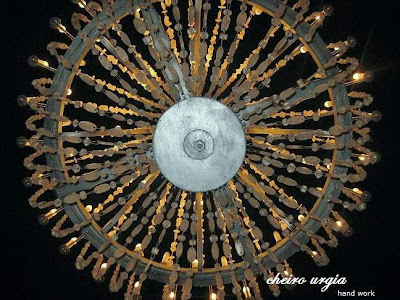Once you reach the Danilowizc shaft you can expect large crowds of tourists waiting to enter the mine on the stairs. However, as we were only two for the German group, our guide decided to use the elevator and saved us two hours of waiting :) Yay!
Inside the mine, the corridors are first covered with wood, while deeper inside they are left blank - and as they are carved into 97% rock salt, the walls taste very salty. With the time, even the wooden walls become soaked with salt and therefore hard as stone.
Due to the presence of salt, the area around Wieliczka was populated some thousand years ago, which is proved by Roman and other archeological findings.
Unlike the first settlers who cooked salty water to gain salt, following generations began to dig for rock salt and removed pieces as heavy as 2 tons with the help of ropes and winches, which were driven by either human or horse power.
And unlike today, when the mine features electricity, AC, toilets and anything you can imagine (even WiFi), miners in the past worked in almost complete darkness with tiny oil lamps. The stairs are much better nowadays, too. With greater and minor accidents, the mortality rate was enormous - 1/3 of the miners didn't make it through the year.
But how could a horse possible get inside the mine? With the same system of ropes. And how did they make it out? Well, never :(
The
waste saltwater (very salty) in the mine was pumped to gain salt,
too, or stored in underground saltwater lakes that are found on each
level of the mine.
Apart
from the miners' work conditions, the mine also tells the story of
the Hungarian princess Kinga who - according to a legend - brought
the mine to Poland in first place: When Kinga married the Polish
king, she asked her father to give her a salt mine for dowry instead
of gold and silver. Before leaving for Poland she threw her
engagement ring into the shaft of the mine, and after arriving in her
new country she told miners to dig in Wieliczka. Soon they found not
only salt, which brought wealth to the city of Kraków, but also her
precious ring.
Next
to Kinga, Wieliczka presents statues of celebrities who visited the
mine, and gnomes who live somewhere below the surface, if you believe
it. Needless to say they are all carved into rock salt, not by some
artists but by the miners themselves.
And
while some of the abandoned corridors and chambers were turned into
fairytale-like scenes by miners, the mine even hosts restaurants, a
conference/concert room, an underground hotel, souvenir shops, a 3D
cinema presentation, exhibition rooms and numerous chapels, the
oldest being from the 17th century.
The most impressive room is without doubt the chapel of St. Kinga. It's huge. It's 100 meters below the surface. And it's entirely carved in rock salt, including the floor and the decorations on the walls - even the chandeliers are made of rock salt crystals!
While the photos do no justice, Mr. Google might provide better impressions ;) and if you're lucky, you may even see a music and light show.
Since we practically had our own guide for the tour, we not only had a one-on-one Q&A, but could arrange the tour as we pleased: spending more time in interesting places and skipping the parts that focused on the technical stuff.
I
never knew what salt grapes are, or that depending on the presence of
metals, salt can be red, green or even blue!The most impressive room is without doubt the chapel of St. Kinga. It's huge. It's 100 meters below the surface. And it's entirely carved in rock salt, including the floor and the decorations on the walls - even the chandeliers are made of rock salt crystals!
While the photos do no justice, Mr. Google might provide better impressions ;) and if you're lucky, you may even see a music and light show.
Since we practically had our own guide for the tour, we not only had a one-on-one Q&A, but could arrange the tour as we pleased: spending more time in interesting places and skipping the parts that focused on the technical stuff.
Our
little "private package" also included full-length video
presentations, overtaking the big groups on our way, and even a
little salty suvenir directly from the mine :)
~ to be continued ~








































No comments:
Post a Comment